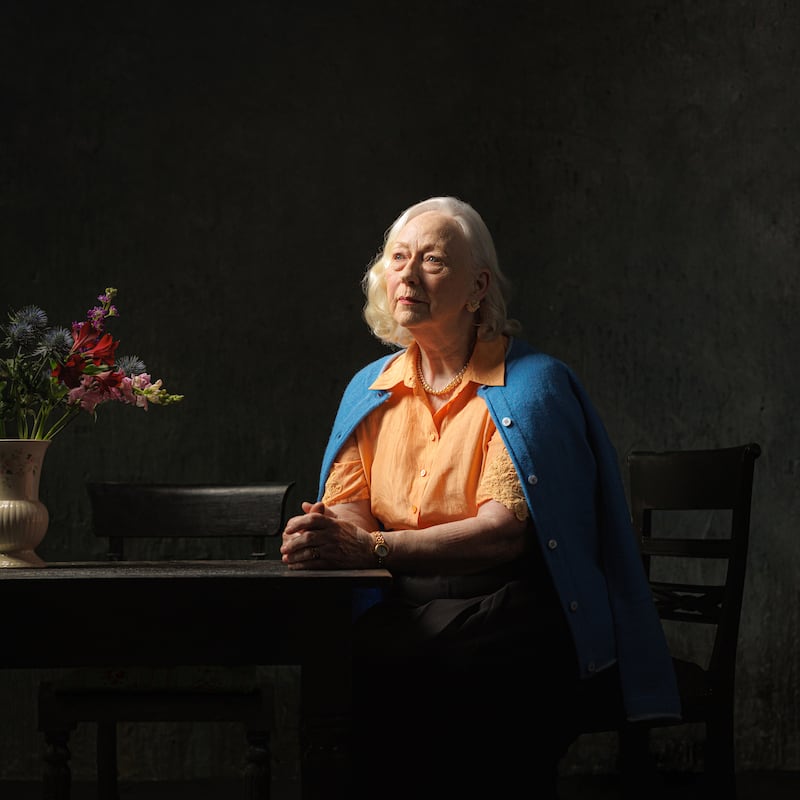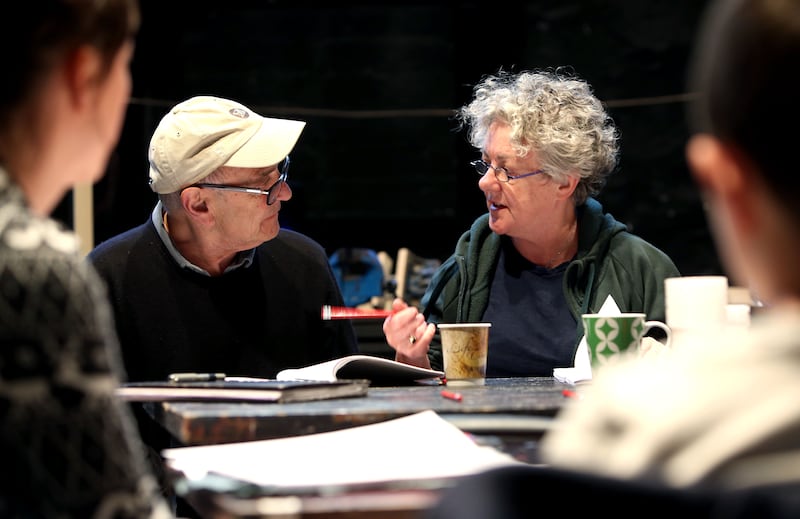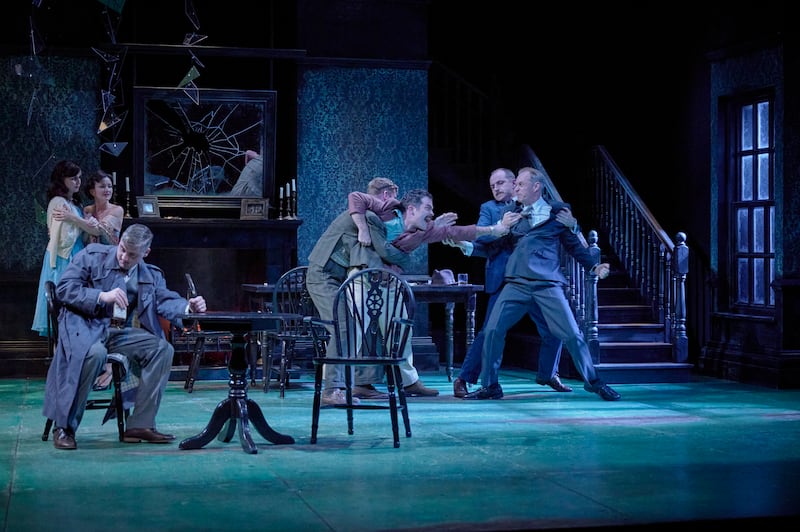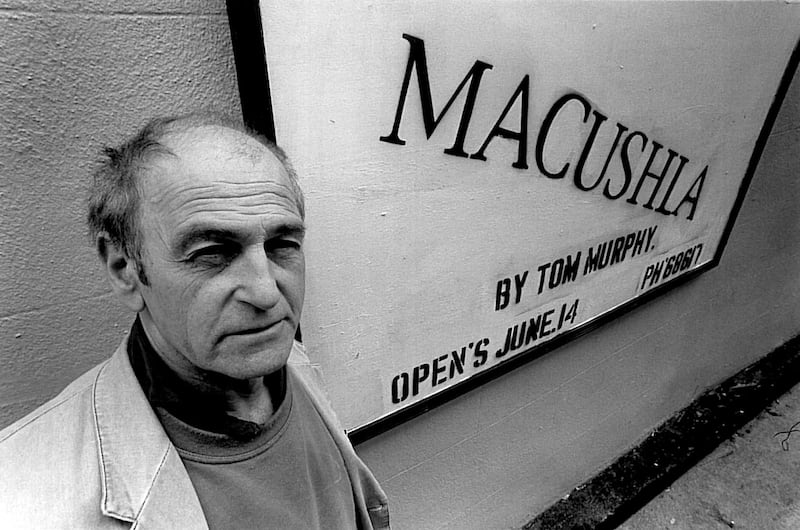“I’m not telling a story against Garry,” the actor Marie Mullen says about an arrangement during rehearsals for the first production of Tom Murphy’s play Bailegangaire, back in the 1980s, which she was appearing in and which Garry Hynes was directing. “They were very good with each other. Tom came in for the first week. Garry said she wouldn’t say a word for the whole week. And she didn’t.”
Jane Brennan, another Murphy actor – who also married him – remarks that “very, very few directors would do that, but it’s an indication of the relationship they had. There was great trust and respect.”
The late playwright was often in and out of rehearsals of Druid productions of his plays; he and they were long-time close collaborators. Now the theatre company that Hynes and Mullen founded with the late Mick Lally in 1975 is staging The House, which Murphy wrote in 2000. It has been running in Galway for the past week, and is about to transfer to Dublin Theatre Festival.
Mullen says, “The one thing I really miss, and Jane’ll understand it – well, Jane is him really, which is great – but I miss having Tom around this time. We had him for DruidMurphy, around with us as a consultation or to hear the laughs in the room. Remember he how he used to laugh?”
RM Block
Brennan chimes in: “His favourite place was in rehearsal rooms. That’s where he was happiest.”
Since Murphy died, in 2018, Hynes has directed his first play, On the Outside, and his version of Chekhov’s The Cherry Orchard. Staging The House is “incredible, actually, because when you’re sitting there you’re trying to work out a scene, and you’re just hearing Tom, his voice. It’s like he’s in the room.”
Is she imagining what he’d say? “A lot of time I don’t have to imagine it. I can absolutely predict it, including all the things he would be objecting to or adjusting or whatever. Because his voice was so distinctive, and because he spoke so like what he wrote, it’s like he’s come alive. It’s incredible.”
If she wanted to go against his wishes, she says, laughing, “I can’t. He’d crash through the ceiling and say no!”
[ Fintan O’Toole: Tom Murphy documented the inner history of modern IrelandOpens in new window ]
Murphy set The House, an epic about emigration and exile, belonging and dispossession, in the 1950s, but it is timeless. Mullen plays Mrs de Burca, the woman in the big house sensing the beginning of an end, realising it’s time to sell the family home as her three daughters’ lives move on. Marty Rea plays Christy Cavanagh, an emigrant with cash in his pockets and designs on the house, one of a bunch of young men home from the building sites, haunting their hometown for a few weeks. Those who left; those who stayed; property and class.
Mullen and Rea are tuned into the cadences and pauses and halting speech of Murphy’s plays, as is Brennan, who was in the first production of The House, at the Abbey in 2000, which Conall Morrison directed.
Brennan was invited to join the Druid cast for their first read-through. “I didn’t even look at the script. I just listened to it,” she says. “Every single character just pinged off the page to life. I was amazed how fresh it sounded. It is so timely. A reminder that we were a nation of emigrants.” She corrects herself: “Are still. Even though it’s set in the 1950s, everything still felt real and there was a real spark to it.”
She mentions all the Irish names figuring at the Olympics, the diaspora so evident. “It’s the other way around now. We’re accepting people into this country. It is very much in the conversation, all of this.”
For Rea, too, “immigration is the bigger echo for me” in terms of the play’s relevance. “Tom wasn’t normally big on basic plots. He’s better than that. You don’t go to a Tom play for just the plot. You go for the sounds of it, the emotional impact of it and the ‘My God, look at how he has formed that thought into a thing using sound and words’.
“But The House is very plot-driven. It seems to me now, in the middle of it, that it’s a story of the effect displacement and emigration have on a human being. Whether you’re male, female, young, old, black, white, from Africa or eastern Europe or America or Ireland, if you have a sense of displacement inside, if you’re finding it difficult to know where you call home, something psychologically is wrong.

“It has a tremendous effect on you, and for us, as an island of emigrants, we know the experience. We have a cultural memory of it for centuries. And to turn around, as some of us are at the moment, and treat other people ... and being completely blind to the fact we know this intimately.
“This play reminds us that, I’m sorry, less than a handful of decades ago it was us in that position. We had a home. We don’t have a home. We don’t know where home is. We need help. I mean, sleeping in a tent by the canal is one thing.” Rea points to his head. “What’s going on in there every night when they put their heads down?
“That’s what the some of these characters are expressing, as Irish people. That’s its strongest note for me.” The individual emigrant experience and the societal phenomenon, “those two things are linked. One informs the other.”
Displacement has many forms in The House. Mullen adds, “It’s always been the way: once you leave, the people at home never let you back in. They say, ‘Oh, great to see you back home. When are you going?’ That’s the next question, always. You don’t belong here any more. You do, but you don’t.
“Even the boys themselves, they’ve got the two weeks home, they’ll spend most of it in the pub. They don’t settle in, except for Christy. Christy has a different need. And Tom never celebrates the homecomings. He shows us how awful it is to come home for the two weeks. But they have to come.”
Brennan says, “It’s a recurring theme in Tom’s work. In A Crucial Week [in the Life of a Grocer’s Assistant] he says, ‘We’re half-men here and half-men away.’”
Also, says Mullen, there’s “the family in the house. It’s just heartbreaking. They’re selling their home. In a way, the mother has come to the realisation the past is the past. She has suffered with the idea of selling it. But when we meet her in the play she’s resigned to it. You have to decide how much of her moving forward and moving in with her daughter is going to be okay. She’s displaced” too.

Rea observes that the town regards the family as “not like us. They’re Normans. They came over. There’s this guy in small-town Ireland, saying they’re only blow-ins – from hundreds of years ago. That is an emigratory story as well. We’re desperate at fencing, very clannish in our thinking.”
“Emigration is built into the DNA of Irish people,” Hynes says, and is “part of the whole story of trying to build a state in the 20s, 30s, 40s, in particular the 50s, that terrible, terrible decade. And Tom explores in The House not only the emigrants – what happens the people who emigrate – but what happens the people who get left behind.
“He does this very well. The emigrants are haunted by the places they grew up and by the people left behind. But the people who stayed, as well, are haunted by those who went away. He does this through the two lead characters, Christy Cavanagh and Mrs de Burca.
“On the face of it the play looks really naturalistic, and it’s Murphy’s voice. But when you go deeper you realise it’s an extraordinary, distinctive play. And while it’s very much about a country we recognise, it also has an epic quality. There is another psychological layer to it that’s fascinating.”
Hynes talks about a sense of place and how “if it’s disturbed it’s not just a matter of missing relatives or familiarities, the landscape you grew up in. It’s fundamental to the essence of how people perceive themselves.” Christy “has absorbed the injuries of emigration without realising it”.
Still pertinent, too, are violence, class and inarticulacy. Those injuries of emigration feed into what Mullen calls “the underlying violence” in Murphy’s plays. “The frustration of violence comes out in different ways, because they don’t understand something.” This comes from the turmoil caused by displacement, says Brennan, “the feeling of exclusion, of being looked down on, the hierarchy of the lawyer, the solicitor and the policeman talking down to the guys.

“That really struck me in the reading, how horrible that was. All that frustration building up inside people, and that feeling: you think you’re better than me? Not belonging and confusion and, in some cases, lack of proper education.”
She references Murphy’s experience of education “with the Christian Brothers, where five people in his class of 42 passed their Inter Cert. The frustration that built in people who feel they have more to offer but don’t have the choices, building into violence because they can’t express themselves properly.”
Mullen: “He articulates the inarticulate.”
It ties in with class, says Rea. “If you can’t afford to be educated you can’t vocalise what you’re feeling inside.” Rea recalls his own experience, the dislocation of going to London at 19 to train as an actor. He didn’t like London, always wanted to come home, but it was never as he remembered or imagined, reprising childhood while staying with parents, and with friends busy with work or children.
“Their lives have moved on, and you’re actually an annoyance. For the week you’re back you’re under everyone’s feet. Susanne de Burca says, ‘God, this family, I come home and I’m depressed already.’
“If you couldn’t afford to be educated, to have the vocabulary to voice this thing, it is held inside. And when you run out of words, that’s when tears or violence happen. Tom, I think, was particularly interested in people who didn’t have the ability to vocalise, to purge stuff by words.”
Brennan quotes Harry in A Whistle in the Dark: “‘Thick lads don’t feel.’ That always breaks my heart, though Harry is such an obnoxious character.” Or, Rea adds, Michael Carney in the same play: just before killing his brother, at the end, “he just shouts the line, ‘You don’t know how to live either,’ and he lashes out. That is almost at the core of every character he writes. ‘How do I do this thing called life?’ And the thing is, ‘You all don’t know how to do it, either, and you are all telling me what to do.’”
[ Modern Ireland in 100 Artworks: 1961 – A Whistle in the Dark, by Tom MurphyOpens in new window ]
Murphy, originally, was going to work on The House as a film, says Brennan. “It’s probably why it’s so plot-driven. Somebody told him the story about the alibi.” An alibi, lightly given, and used for a more significant purpose, is at the core of the plot. “He thought that was a great idea, and he started to write. It was such a great story, but then he started to resent the fact that he was having to stick to the story.
“And because he didn’t like writing plots – he liked like writing character and feeling and bringing you to these places emotionally, rather than through conventional plot – he felt at one point when he was writing it that it was constraining him, in a way. But he stuck with it, and it probably is the only conventionally plot-driven play he’s written.”
Murphy “used to talk about outrage”, says Rea. “He would talk about the big institutions of Ireland that drove him insane. The government, the church, the education system, he really railed against. People would say, ‘You’re so full of rage,’ and he’d say, ‘No, no. It’s not rage, it’s outrage,’ which to me just sounds so much more productive, as an artist anyways. For all the best writers, plot is secondary – tertiary, sometimes – to the main act, the craft of writing words to make you feel something through language. I think this play, because it’s the most plot-driven, becomes outraged itself.”
Rea adds, “A lot of people think of Tom as this gritty, naturalist, realistic writer. Very male-driven and urban, nearly, and violent. And, actually, the vast majority of Tom’s work is not that. It’s much more creative, expressionistic, impressionistic, magical realist, I think.”
Murphy is closer to Salman Rushdie than to Harold Pinter, Rea argues. “A lot of young men coming up through drama schools want to be in a Murphy play because they’re going to get to punch the wall and roar. And great, do that if you want, but you just end up with a sore hand. You’re not going to get the play right.

“Actually, there’s huge heart, tenderness. And mainly, I think, he’d ultimately want his plays to be sung. There’s this beauty and tenderness that comes through singing and music. That’s how he writes; that’s how he hears things.”
When his script indicates singing a line, Murphy meant it literally. Mullen sings lines from the play, demonstrating, trying them out. “Louise, love, Louise, love ... The tone of the thing, trying to draaaaw the person, you know the way you would with your child.”
Brennan imagines that, were Murphy still writing today, he’d be working on a version of the Oresteia that he’d started before he died. She also mentions Stolen, the recent RTÉ documentary about mother and baby homes. Murphy was interested in the work of Catherine Corless, the Galway historian who uncovered a mass grave next to a home in Tuam, where 796 infants died between 1925 and 1961.
Murphy “grew up in Tuam, and didn’t even know it was a mother and baby home,” Brennan says. “He thought it was just an orphanage. There were orphans in his school. They were dressed differently, and he said they used to make this really high-pitched little sound. A feral kind of thing. He was very deeply upset by the discovery [of the babies’ remains] there.”
It makes them all think immediately of the line in Bailegangaire about “the unbaptised an’ stillborn in shoeboxes planted”.
“So God knows,” says Brennan, “there would be plenty of material still for him, to mine all of that.”
In the meantime there is The House, still echoing, resonating, nearly a quarter of a century after Murphy wrote it. “Companies just don’t take on big plays now,” Brennan says. “Druid doing this now, it’s just fantastic.”
It’s a hefty play, with big, meaty themes, a sweep through the Irish psyche, full of character, significance and plot. “It’s a tractor,” Mullen says with delight. “It’s a Massey Ferguson.”
They roar laughing and head into rehearsals.
The Druid production of The House is at the Gaiety Theatre, as part of Dublin Theatre Festival, from Thursday, September 26th, until Sunday, October 6th






















